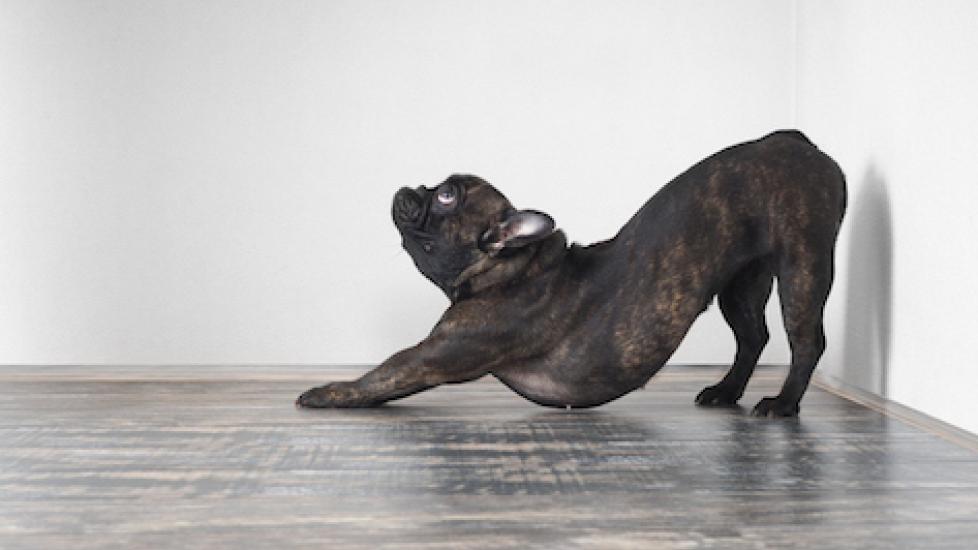5 Stretches for Senior Dogs
By Monica Weymouth
If you’ve ever gone to a yoga class, you know how good a proper stretching session can be for your body. The stiffness melts away, the aches mysteriously dissolve and, over time, your joints become stronger and healthier.
While your pup might not be up for a vinyassa flow, he could benefit from a dog stretching routine—especially if he’s approaching his golden years.
“Stretching can be a great tool to help pets maintain mobility and comfort as they age,” says veterinarian Christina Fuoco, medical director at Philadelphia’s Whole Animal Gym. “An arthritic joint can stiffen up and some range of motion exercises can help preserve function, as well as decrease pain.”
As always, if you suspect your dog has arthritis or is experiencing any discomfort, a visit to your veterinarian is in order. Once you understand your senior dog’s needs and limitations and have discussed a dog stretching regimen with your veterinarian, try these therapeutic stretches with your canine companion.
The Bicycle
Don’t tell the Instagram yogis, but a stretch doesn’t have to be elaborate to be beneficial—in fact, it barely has to stretch. “One of the best ‘stretches’ is actually just moving the joint through range of motion and not putting significant tension on the muscles,” Fuoco says. For aging dogs, she recommends gently “bicycling” the hind legs, a motion that warms the joint fluid and improves blood flow to help joints and muscles feel more comfortable. This passive stretch also helps improve the gait of senior pets, allowing them to stay active.
Shoulder Extension
As a certified canine rehabilitation therapist, Sasha Foster is a dog stretching evangelist. “The importance of stretching your older dog cannot be overstated,” she says. Her e-book, "Old Dog! Exercises and Stretches to Feel Good,” details how to stretch a dog using a variety of stretches, including the shoulder extension.
To perform it, have your dog lie on his side and stabilize the shoulder joint by placing one hand over the point of the shoulder and applying gentle pressure. Place your other hand under his leg and gently lift it parallel to the floor. With the elbow straight, gently move the leg toward the head until you feel resistance, then hold for 20 to 30 seconds.
Sit and Stand
As our pups age, many of us will stop giving them “sit” cues if the motion appears to be challenging. This could be a mistake—and, in fact, could actually contribute to future discomfort.
“Sitting and rising to a stand is a wonderful active exercise to help improve range of motion in the hips and knees,” Fuoco says. It’s important to determine if your dog is, indeed, comfortable enough to do the familiar motion—if he resists or shows aggression, these are clear signs it’s too intense. To determine your senior pet’s limits and the appropriate amount of activity, Fuoco recommends consulting with a rehab specialist.
Hip Flexion
If hips are a problem area, consider this gentle stretch, a favorite of Foster’s for senior dogs. As your dog lies on his side, place the palm of one hand over his upper back leg bone to support the joint. Place your other hand under the leg, lifting it parallel to the floor. Allow the knee to bend, then slowly guide the leg along the side of the body until you feel resistance; then, hold for 20 to 30 seconds.
The Play Bow
The “play bow” is aptly named—it’s the motion a dog does when he’s preparing to play, whether with another animal or with his human. When in the position, a dog brings his chest low to the ground and his front legs stretch out in front of him.
Fuoco recommends the stretch for after walks or vigorous activity. “A play bow is a nice stretch to the groin muscles, an area that many dogs will overwork if they have any subtle knee injuries,” she says. To encourage your dog to bow, do the position yourself—he’ll likely reciprocate, and everyone will enjoy a nice stretch.
